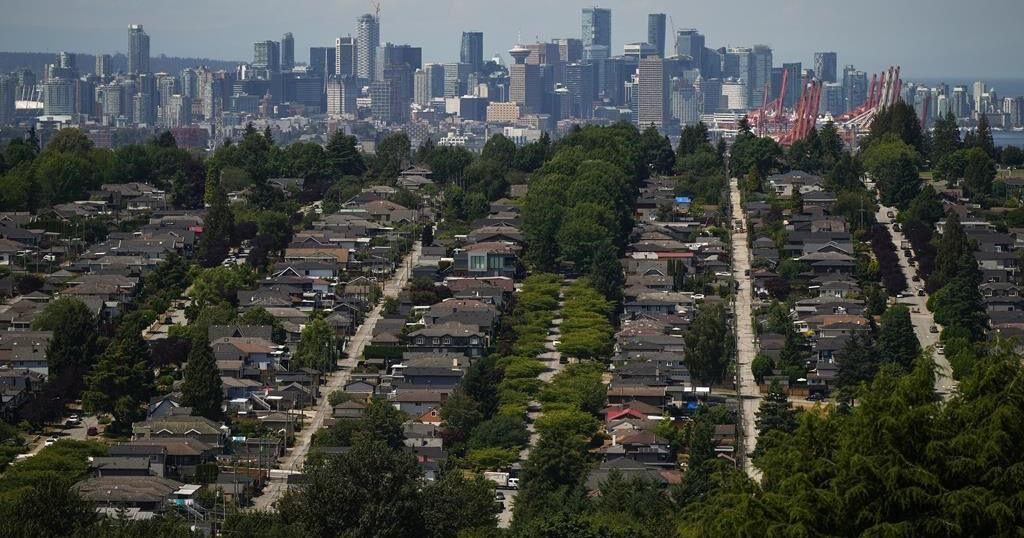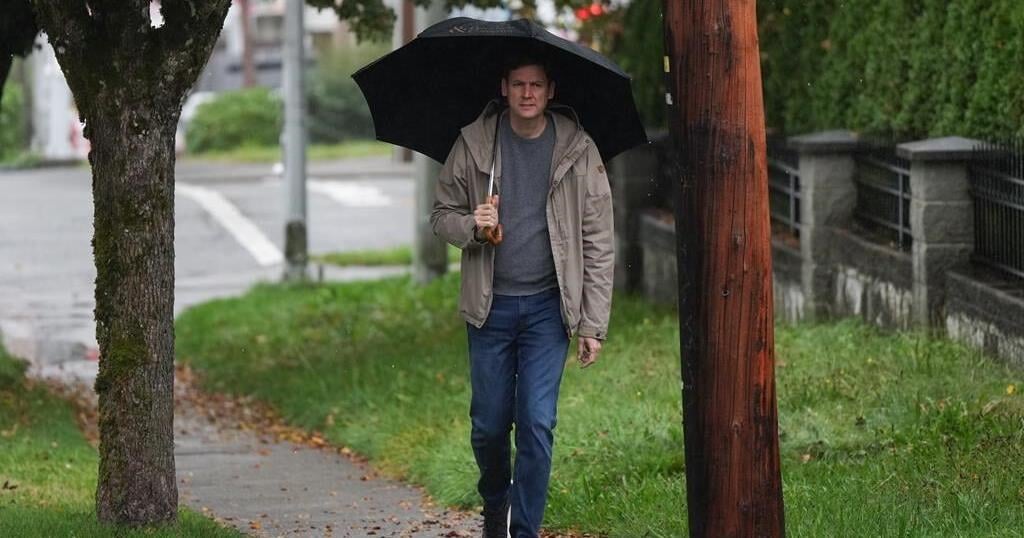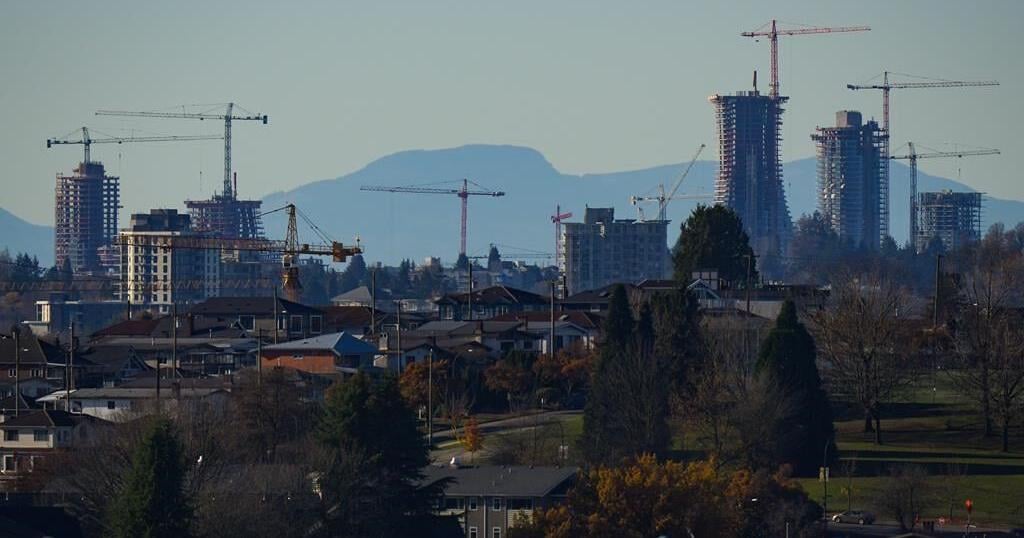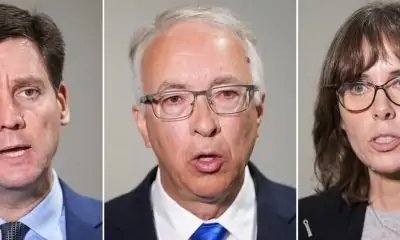Not only is it a private venture, it’s a fascinating peek into the reasons people build new homes in old areas.
Real eState
Real estate: New infill causes buzz in Buena Vista – Saskatoon StarPhoenix

Mike and Lona Finney are building their retirement home on the corner of Sixth Street and Eastlake Avenue in Saskatoon. (photo by Joanne Paulson)
One day last summer, the side of the house on the corner of Sixth Street and Eastlake Avenue was torn off. Poof, there went the porch. Down came a couple of old trees.
The community buzz began. What were those people doing? Who were they? What was happening?
It seemed like two minutes later when a concrete foundation was poured next door. The frame went up, and the walls began to rise. The owners had evidently split the lot and were building a new infill in tree-lined, lovely Buena Vista.
“Those people” proved to be Mike and Lona Finney, a mechanical engineer and home care business owner, respectively. As it turns out, this is no ordinary infill. Not only is it a private venture, it’s a fascinating peek into the reasons people build new homes in old areas.

Mike and Lona Finney are building their retirement home on the corner of Sixth Street and Eastlake Avenue in Saskatoon. (photo by Joanne Paulson)
Saskatoon
The couple had been seeking a location like this for a long time. They owned a large home in another neighbourhood, but when their kids moved out, it seemed a little much for two people.
Then this property came up for sale. Some months and negotiations later, they bought it, seeing potential in the 58 x 125 foot lot.
Helpfully, there is expertise on their side. Mike has renovated homes all his working life, although he has never built a new house. Lona’s experience with her business, Saskatoon Home Support, has opened their eyes to the challenges of getting older. This will be their retirement home.
“Our master bedroom, everything is on the main floor,” Mike said in an interview. “It’s wheelchair accessible, set up for us to retire in.”
The front of the house will feature a 10 x 15 foot sunroom with a swim spa measuring six by 10 feet. Behind it is a great room, kitchen and dining area; the back bedroom contains an ensuite and steam shower. The bathroom will also be accessible to guests, eliminating the need to dedicate space for a second, smaller bathroom.
Upstairs will be two bedrooms that can easily be converted into four or five, should a larger family live there in the future. The Finneys will use the extra space as a bonus room with fireplace.
“We can sustainably live on the main floor … until we have to move on,” Lona said. “That was another main goal of this build. So many times I see that, if you’re in a two-storey condo or house, and something happens — we can all fall and break a hip, you don’t have to be 90 — and you don’t have a bathroom downstairs, or maybe a half bath, you don’t have a shower … there are so many things (to consider).
“And then you have to make a rash decision (if) you have to move.”
The process is not for the faint of heart. Mike had an advantage, since he deals with building permits all the time, and knew how to do due diligence to ensure he could split the lot and build the house.
He had the lot legally surveyed before they bought the property. To accomplish the split, he had to take out permits to change the existing garage and deck, and to rip off the side of the house. He submitted his plans and then had to wait for a building permit before he could legally subdivide it. In addition, all the utility companies had to approve the subdivision.
By code, the existing home’s exterior wall facing the new home must be fire-rated, so the Finneys will have to replace all the windows on that side, as well as put a new front door facing the east-west street, and slice off part of the garage. The 1929 home will also get a new deck.
“We are so lucky that he has this knowledge base,” Lona said. “He did all these plans … he’s got that mind and can do that.”
“It’s also being able to recognize the potential,” Mike added.
The tree-removal issue generated some conversation, and perhaps consternation, in the neighbourhood. Trees are often protected during an infill build, but in this case some had to come down, and not just to make room for the new house. The Finneys hired an arborist, who told them two of the old trees had split and would eventually fall, potentially causing damage.
Mike has an additional take on trees versus housing, stemming from his interest in sustainability.
“Sustainability is more people per square foot,” he said. “I’d love a great debate over whether or not (we should be) taking a tree down and putting a house there … we’re now going to house two families here instead of one.” They intend to keep the existing home as a rental.
Adding to the sustainability aspect of the new home, the Finneys are building to new energy codes as set out by the National Energy Code for Buildings (NECB); the new code came into effect on Jan. 1, 2019.
“Our house will consume one-third less than the model house of this size,” he said. “It’s very efficient. We’re going to be future-proofed for solar panels as well, to go on the garage.”
Furthermore, the Finneys are finding that they’re using their vehicles less and walking much more often, particularly to Broadway Avenue. Walkability is a big advantage to living in a core neighbourhood. If you can reduce your environmental footprint, age in place, add to density and enjoy the advantages of a new home, an infill is a good choice.
Real eState
Here are some facts about British Columbia’s housing market

Housing affordability is a key issue in the provincial election campaign in British Columbia, particularly in major centres.
Here are some statistics about housing in B.C. from the Canada Mortgage and Housing Corporation’s 2024 Rental Market Report, issued in January, and the B.C. Real Estate Association’s August 2024 report.
Average residential home price in B.C.: $938,500
Average price in greater Vancouver (2024 year to date): $1,304,438
Average price in greater Victoria (2024 year to date): $979,103
Average price in the Okanagan (2024 year to date): $748,015
Average two-bedroom purpose-built rental in Vancouver: $2,181
Average two-bedroom purpose-built rental in Victoria: $1,839
Average two-bedroom purpose-built rental in Canada: $1,359
Rental vacancy rate in Vancouver: 0.9 per cent
How much more do new renters in Vancouver pay compared with renters who have occupied their home for at least a year: 27 per cent
This report by The Canadian Press was first published Oct. 17, 2024.
The Canadian Press. All rights reserved.
Real eState
B.C. voters face atmospheric river with heavy rain, high winds on election day

VANCOUVER – Voters along the south coast of British Columbia who have not cast their ballots yet will have to contend with heavy rain and high winds from an incoming atmospheric river weather system on election day.
Environment Canada says the weather system will bring prolonged heavy rain to Metro Vancouver, the Sunshine Coast, Fraser Valley, Howe Sound, Whistler and Vancouver Island starting Friday.
The agency says strong winds with gusts up to 80 kilometres an hour will also develop on Saturday — the day thousands are expected to go to the polls across B.C. — in parts of Vancouver Island and Metro Vancouver.
Wednesday was the last day for advance voting, which started on Oct. 10.
More than 180,000 voters cast their votes Wednesday — the most ever on an advance voting day in B.C., beating the record set just days earlier on Oct. 10 of more than 170,000 votes.
Environment Canada says voters in the area of the atmospheric river can expect around 70 millimetres of precipitation generally and up to 100 millimetres along the coastal mountains, while parts of Vancouver Island could see as much as 200 millimetres of rainfall for the weekend.
An atmospheric river system in November 2021 created severe flooding and landslides that at one point severed most rail links between Vancouver’s port and the rest of Canada while inundating communities in the Fraser Valley and B.C. Interior.
This report by The Canadian Press was first published Oct. 17, 2024.
The Canadian Press. All rights reserved.
News
No shortage when it comes to B.C. housing policies, as Eby, Rustad offer clear choice

British Columbia voters face no shortage of policies when it comes to tackling the province’s housing woes in the run-up to Saturday’s election, with a clear choice for the next government’s approach.
David Eby’s New Democrats say the housing market on its own will not deliver the homes people need, while B.C. Conservative Leader John Rustad saysgovernment is part of the problem and B.C. needs to “unleash” the potential of the private sector.
But Andy Yan, director of the City Program at Simon Fraser University, said the “punchline” was that neither would have a hand in regulating interest rates, the “giant X-factor” in housing affordability.
“The one policy that controls it all just happens to be a policy that the province, whoever wins, has absolutely no control over,” said Yan, who made a name for himself scrutinizing B.C.’s chronic affordability problems.
Some metrics have shown those problems easing, with Eby pointing to what he said was a seven per cent drop in rent prices in Vancouver.
But Statistics Canada says 2021 census data shows that 25.5 per cent of B.C. households were paying at least 30 per cent of their income on shelter costs, the worst for any province or territory.
Yan said government had “access to a few levers” aimed at boosting housing affordability, and Eby has been pulling several.
Yet a host of other factors are at play, rates in particular, Yan said.
“This is what makes housing so frustrating, right? It takes time. It takes decades through which solutions and policies play out,” Yan said.
Rustad, meanwhile, is running on a “deregulation” platform.
He has pledged to scrap key NDP housing initiatives, including the speculation and vacancy tax, restrictions on short-term rentals,and legislation aimed at boosting small-scale density in single-family neighbourhoods.
Green Leader Sonia Furstenau, meanwhile, says “commodification” of housing by large investors is a major factor driving up costs, and her party would prioritize people most vulnerable in the housing market.
Yan said it was too soon to fully assess the impact of the NDP government’s housing measures, but there was a risk housing challenges could get worse if certain safeguards were removed, such as policies that preserve existing rental homes.
If interest rates were to drop, spurring a surge of redevelopment, Yan said the new homes with higher rents could wipe the older, cheaper units off the map.
“There is this element of change and redevelopment that needs to occur as a city grows, yet the loss of that stock is part of really, the ongoing challenges,” Yan said.
Given the external forces buffeting the housing market, Yan said the question before voters this month was more about “narrative” than numbers.
“Who do you believe will deliver a better tomorrow?”
Yan said the market has limits, and governments play an important role in providing safeguards for those most vulnerable.
The market “won’t by itself deal with their housing needs,” Yan said, especially given what he described as B.C.’s “30-year deficit of non-market housing.”
IS HOUSING THE ‘GOVERNMENT’S JOB’?
Craig Jones, associate director of the Housing Research Collaborative at the University of British Columbia, echoed Yan, saying people are in “housing distress” and in urgent need of help in the form of social or non-market housing.
“The amount of housing that it’s going to take through straight-up supply to arrive at affordability, it’s more than the system can actually produce,” he said.
Among the three leaders, Yan said it was Furstenau who had focused on the role of the “financialization” of housing, or large investors using housing for profit.
“It really squeezes renters,” he said of the trend. “It captures those units that would ordinarily become affordable and moves (them) into an investment product.”
The Greens’ platform includes a pledge to advocate for federal legislation banning the sale of residential units toreal estate investment trusts, known as REITs.
The party has also proposed a two per cent tax on homes valued at $3 million or higher, while committing $1.5 billion to build 26,000 non-market units each year.
Eby’s NDP government has enacted a suite of policies aimed at speeding up the development and availability of middle-income housing and affordable rentals.
They include the Rental Protection Fund, which Jones described as a “cutting-edge” policy. The $500-million fund enables non-profit organizations to purchase and manage existing rental buildings with the goal of preserving their affordability.
Another flagship NDP housing initiative, dubbed BC Builds, uses $2 billion in government financingto offer low-interest loans for the development of rental buildings on low-cost, underutilized land. Under the program, operators must offer at least 20 per cent of their units at 20 per cent below the market value.
Ravi Kahlon, the NDP candidate for Delta North who serves as Eby’s housing minister,said BC Builds was designed to navigate “huge headwinds” in housing development, including high interest rates, global inflation and the cost of land.
Boosting supply is one piece of the larger housing puzzle, Kahlon said in an interview before the start of the election campaign.
“We also need governments to invest and … come up with innovative programs to be able to get more affordability than the market can deliver,” he said.
The NDP is also pledging to help more middle-class, first-time buyers into the housing market with a plan to finance 40 per cent of the price on certain projects, with the money repayable as a loan and carrying an interest rate of 1.5 per cent. The government’s contribution would have to be repaid upon resale, plus 40 per cent of any increase in value.
The Canadian Press reached out several times requesting a housing-focused interview with Rustad or another Conservative representative, but received no followup.
At a press conference officially launching the Conservatives’ campaign, Rustad said Eby “seems to think that (housing) is government’s job.”
A key element of the Conservatives’ housing plans is a provincial tax exemption dubbed the “Rustad Rebate.” It would start in 2026 with residents able to deduct up to $1,500 per month for rent and mortgage costs, increasing to $3,000 in 2029.
Rustad also wants Ottawa to reintroduce a 1970s federal program that offered tax incentives to spur multi-unit residential building construction.
“It’s critical to bring that back and get the rental stock that we need built,” Rustad said of the so-called MURB program during the recent televised leaders’ debate.
Rustad also wants to axe B.C.’s speculation and vacancy tax, which Eby says has added 20,000 units to the long-term rental market, and repeal rules restricting short-term rentals on platforms such as Airbnb and Vrbo to an operator’s principal residence or one secondary suite.
“(First) of all it was foreigners, and then it was speculators, and then it was vacant properties, and then it was Airbnbs, instead of pointing at the real problem, which is government, and government is getting in the way,” Rustad said during the televised leaders’ debate.
Rustad has also promised to speed up approvals for rezoning and development applications, and to step in if a city fails to meet the six-month target.
Eby’s approach to clearing zoning and regulatory hurdles includes legislation passed last fall that requires municipalities with more than 5,000 residents to allow small-scale, multi-unit housing on lots previously zoned for single family homes.
The New Democrats have also recently announced a series of free, standardized building designs and a plan to fast-track prefabricated homes in the province.
A statement from B.C.’s Housing Ministry said more than 90 per cent of 188 local governments had adopted the New Democrats’ small-scale, multi-unit housing legislation as of last month, while 21 had received extensions allowing more time.
Rustad has pledged to repeal that law too, describing Eby’s approach as “authoritarian.”
The Greens are meanwhile pledging to spend $650 million in annual infrastructure funding for communities, increase subsidies for elderly renters, and bring in vacancy control measures to prevent landlords from drastically raising rents for new tenants.
Yan likened the Oct. 19 election to a “referendum about the course that David Eby has set” for housing, with Rustad “offering a completely different direction.”
Regardless of which party and leader emerges victorious, Yan said B.C.’s next government will be working against the clock, as well as cost pressures.
Yan said failing to deliver affordable homes for everyone, particularly people living on B.C. streets and young, working families, came at a cost to the whole province.
“It diminishes us as a society, but then also as an economy.”
This report by The Canadian Press was first published Oct. 17, 2024.
-

 News22 hours ago
News22 hours agoCanadanewsmedia news October 18, 2024: Testy B.C. election campaign reaches final day
-

 News22 hours ago
News22 hours agoUS to probe Tesla’s ‘Full Self-Driving’ system after pedestrian killed in low visibility conditions
-

 News22 hours ago
News22 hours agoAdvocates urge Ontario to change funding for breast prostheses, ostomy supplies
-

 News22 hours ago
News22 hours agoMore details expected on proposed deal that would see tobacco giants pay billions
-

 News22 hours ago
News22 hours ago‘Kindness’ influencers on TikTok give money to strangers. Why is that controversial?
-

 News22 hours ago
News22 hours agoHousing, health, and plastic straws: Here’s how B.C. politicians are wooing voters
-

 News22 hours ago
News22 hours agoTesty B.C. election campaign sees leaders attacking each other more than policy
-

 News22 hours ago
News22 hours agoRwanda shrugs off ‘sportswashing’ criticism in pursuit of a winning development formula





















